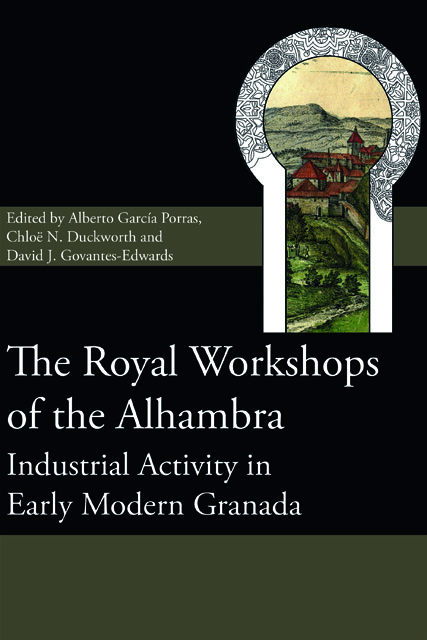Book contents
- Frontmatter
- Contents
- List of Illustrations
- List of Contributors
- Acknowledgements
- Foreword
- Introduction
- 1 The Secano: the city of the Alhambra
- 2 A holistic and reflexive methodology for the archaeological investigation of pyrotechnological activity in the Alhambra
- 3 The modern kilns
- 4 Geophysical and geochemical exploration of the industrial areas in the Alhambra
- 5 The excavation of the area of the Secano in the Alhambra: Trench 1
- 6 The excavation of the area of the Secano in the Alhambra: Trench 2
- 7 The pottery
- 8 Glass in the excavation of the Secano, the Alhambra
- 9 Furnaces at full blast: the demand for architectural ceramics for construction in the Alhambra (16th and 17th centuries)
- Conclusions
- Index
8 - Glass in the excavation of the Secano, the Alhambra
Published online by Cambridge University Press: 20 December 2023
- Frontmatter
- Contents
- List of Illustrations
- List of Contributors
- Acknowledgements
- Foreword
- Introduction
- 1 The Secano: the city of the Alhambra
- 2 A holistic and reflexive methodology for the archaeological investigation of pyrotechnological activity in the Alhambra
- 3 The modern kilns
- 4 Geophysical and geochemical exploration of the industrial areas in the Alhambra
- 5 The excavation of the area of the Secano in the Alhambra: Trench 1
- 6 The excavation of the area of the Secano in the Alhambra: Trench 2
- 7 The pottery
- 8 Glass in the excavation of the Secano, the Alhambra
- 9 Furnaces at full blast: the demand for architectural ceramics for construction in the Alhambra (16th and 17th centuries)
- Conclusions
- Index
Summary
One of the most prominent features of the excavation of the area of the Secano was the large number of glass fragments found, many of which correspond to production remains (scoria, threads, drops, etc.). This strongly suggests that glass-working activities were being carried out in situ. Many of these remains were found in contexts that are not easy to date, owing to the peculiarities of the site’s sequence, but many others have been securely dated to either side of the Christian takeover of the city in 1492, on both stratigraphic and typological grounds. This, in combination with the identification of a glaze furnace in Trench 1, makes the Secano a potentially crucial site for exploring glass and glaze technology and its evolution before and after the conquest. It is to be emphasized that glass and glazing technologies were strongly interrelated crafts throughout the Middle Ages, and this close relationship seems to have continued into the Early Modern Age, but the way their connections were articulated is not always perfectly understood, so the study of sites such as the Secano, in which both crafts are in direct contact during a potentially critical juncture in terms of the transmission of technology, can be enormously relevant. Apart from the production remains, the assemblage recovered includes various type of glass items, including blown and mould-blown artefacts, architectural glass, and ornamental items (often worked at lower temperatures than blown glass) such as bangles and figurines.
Keywords: Late medieval and early modern Spain; archaeological glass; glass production; glass typology.
Introduction
Glass is commonly found in archaeological excavations, often in small fragments as a result of its characteristic fragility. However, despite the important role that glass played in historical societies, archaeology has paid relatively little attention to this material, at least in comparison to other materials such as ceramics. One of the main reasons for this is that glass is not considered a reliable chronological indicator, as glass typologies often remained unchanged for long periods of time. Even so, the study of archaeological glass is crucial if we are to fully understand its value for past societies, as well as the associated mechanisms of production and circulation.
Since the production of the earliest glass objects, in the mid-3rd millennium B.C., the consumption of glass has done nothing but increase.
- Type
- Chapter
- Information
- The Royal Workshops of the AlhambraIndustrial Activity in Early Modern Granada, pp. 135 - 148Publisher: Boydell & BrewerPrint publication year: 2022



